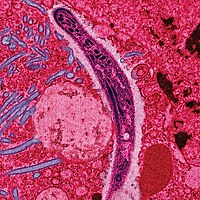
Photo from wikipedia
Significance Influenza infection elicits strong, long-lived protective antibodies, but most current influenza vaccines give weaker, short-lived protection. We noted that live virus is still replicating, making antigen and causing inflammation… Click to show full abstract
Significance Influenza infection elicits strong, long-lived protective antibodies, but most current influenza vaccines give weaker, short-lived protection. We noted that live virus is still replicating, making antigen and causing inflammation at 7 d postinfection (dpi), while an inactivated vaccine provides antigen for at most 4 dpi. We show that the generation of key T follicular helper cells (TFH) requires they recognize antigen locally at 6 dpi in the presence of ongoing viral infection. This creates a checkpoint that restricts TFH responses to dangerous infections that persist through the checkpoint. Using a live attenuated vaccine, akin to Flumist, we found that adding a second dose at 6 d generated a strong TFH response, suggesting an approach to improve vaccine strategies. While influenza infection induces robust, long-lasting, antibody responses and protection, including the T follicular helper cells (TFH) required to drive B cell germinal center (GC) responses, most influenza vaccines do not. We investigated the mechanisms that drive strong TFH responses during infection. Infection induces viral replication and antigen (Ag) presentation lasting through the CD4 effector phase, but Ag and pathogen recognition receptor signals are short-lived after vaccination. We analyzed the need for both infection and Ag presentation at the effector phase, using an in vivo sequential transfer model to time their availability. Differentiation of CD4 effectors into TFH and GC-TFH required that they recognize Ag locally in the site of TFH development, at the effector phase, but did not depend on specific Ag-presenting cells (APCs). In addition, concurrent signals from infection were necessary even when sufficient Ag was presented. Providing these signals with a second dose of live attenuated influenza vaccine at the effector phase drove TFH and GC-TFH development equivalent to live infection. The results suggest that vaccine approaches can induce strong TFH development that supports GC responses akin to infection, if they supply these effector phase signals at the right time and site. We suggest that these requirements create a checkpoint that ensures TFH only develop fully when infection is still ongoing, thereby avoiding unnecessary, potentially autoimmune, responses.
Journal Title: Proceedings of the National Academy of Sciences of the United States of America
Year Published: 2022
Link to full text (if available)
Share on Social Media: Sign Up to like & get
recommendations!